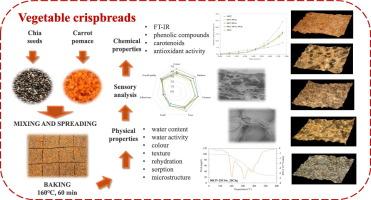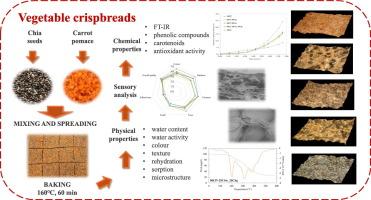Valorisation of carrot pomace for novel crispbread development using the potential of chia seeds (Salvia hispanica L.) as a texturising agent
IF 9.8
1区 农林科学
Q1 CHEMISTRY, APPLIED
引用次数: 0
Abstract
Carrot pomace is a by-product derived from juice processing that offers a sustainable source of bioactive compounds such as carotenoids and phenolic compounds. This work has aimed to develop and characterise gluten-free vegetable crispbread by means of fresh carrot pomace and chia seeds as a texturising agent. Physical and chemical analyses were conducted, including the measurement of water content and activity, colour, texture, Fourier transform infrared spectroscopy (FT-IR), sorption and thermal properties, rehydration capacity, microstructure observations, sensory evaluation, antioxidant activity, total phenolic content, and carotenoid content. Carrot pomace and whole or ground chia seeds were used in varying proportions for producing crispbread through a drying process. The produced snacks were characterised by low moisture content (0.88–6.87 %) and low water activity (0.205–0.263). Owing to the use of those raw materials, the prepared snacks exhibited phenolic compounds (257.25–1069.84 mg GAE/100 g d.m.), carotenoids (0.08–13.71 mg/100 g d.m.) and antioxidant activity, thereby providing beneficial nutritional value. The FT-IR analysis revealed the presence of several functional groups, including the carbonyl group (C=O) found in fatty acid esters and lipids, C-O associated with carbohydrates, and hydroxyl groups (-OH) present in water molecules, phenolic compounds, carbohydrates, or alcohols. The results have proven that carrot pomace combined with chia seeds may be used for producing vegetable crispbread, thereby enjoying the desirable texture and sensory acceptance.


利用鼠尾草籽(Salvia hispanica L.)作为质地化剂的潜力开发新型脆皮胡萝卜渣的价值
胡萝卜渣是果汁加工的副产品,它提供了类胡萝卜素和酚类化合物等生物活性化合物的可持续来源。本工作旨在通过新鲜胡萝卜渣和奇亚籽作为发质剂来开发和表征无麸质蔬菜脆饼。进行了物理和化学分析,包括含水量和活度、颜色、质地、傅里叶变换红外光谱(FT-IR)、吸附和热性能、再水化能力、微观结构观察、感官评价、抗氧化活性、总酚含量和类胡萝卜素含量的测量。胡萝卜渣和整个或磨碎的奇亚籽以不同比例用于通过干燥过程生产脆饼。所生产的零食具有低水分含量(0.88 ~ 6.87 %)和低水分活度(0.205 ~ 0.263)的特点。由于使用了这些原料,制成的零食具有酚类化合物(7.25-1069.84 mg GAE/100 g dm)、类胡萝卜素(0.08-13.71 mg/100 g dm)和抗氧化活性,从而提供了有益的营养价值。FT-IR分析揭示了几个官能团的存在,包括在脂肪酸酯和脂质中发现的羰基(C=O),与碳水化合物相关的CO,以及存在于水分子、酚类化合物、碳水化合物或醇中的羟基(-OH)。结果表明,胡萝卜渣与奇亚籽混合可用于蔬菜脆饼的制作,从而获得理想的口感和感官接受度。
本文章由计算机程序翻译,如有差异,请以英文原文为准。
求助全文
约1分钟内获得全文
求助全文
来源期刊

Food Chemistry
工程技术-食品科技
CiteScore
16.30
自引率
10.20%
发文量
3130
审稿时长
122 days
期刊介绍:
Food Chemistry publishes original research papers dealing with the advancement of the chemistry and biochemistry of foods or the analytical methods/ approach used. All papers should focus on the novelty of the research carried out.
 求助内容:
求助内容: 应助结果提醒方式:
应助结果提醒方式:


